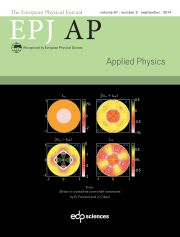Crossref Citations
This article has been cited by the following publications. This list is generated based on data provided by
Crossref.
Gun'ko, Y. K.
Pillai, S. C.
and
McInerney, D.
2001.
Magnetic nanoparticles and nanoparticle assemblies from metallorganic precursors.
Journal of Materials Science: Materials in Electronics,
Vol. 12,
Issue. 4-6,
p.
299.
Wormuth, Klaus
2001.
Superparamagnetic Latex via Inverse Emulsion Polymerization.
Journal of Colloid and Interface Science,
Vol. 241,
Issue. 2,
p.
366.
Pardoe, Heath
Chua-anusorn, Wanida
St. Pierre, Timothy G.
and
Dobson, Jon
2001.
Structural and magnetic properties of nanoscale iron oxide particles synthesized in the presence of dextran or polyvinyl alcohol.
Journal of Magnetism and Magnetic Materials,
Vol. 225,
Issue. 1-2,
p.
41.
Sanchez, C.
Soler-Illia, G. J. de A. A.
Ribot, F.
Lalot, T.
Mayer, C. R.
and
Cabuil, V.
2001.
Designed Hybrid Organic−Inorganic Nanocomposites from Functional Nanobuilding Blocks.
Chemistry of Materials,
Vol. 13,
Issue. 10,
p.
3061.
Ramírez, Liliana P.
and
Landfester, Katharina
2003.
Magnetic Polystyrene Nanoparticles with a High Magnetite Content Obtained by Miniemulsion Processes.
Macromolecular Chemistry and Physics,
Vol. 204,
Issue. 1,
p.
22.
Landfester, Katharina
and
Ram rez, Liliana P
2003.
Encapsulated magnetite particles for biomedical application.
Journal of Physics: Condensed Matter,
Vol. 15,
Issue. 15,
p.
S1345.
Landfester, Katharina
2003.
Colloidal Polymers.
Vol. 20036129,
Issue. ,
Lesieur, Sylviane
Grabielle-Madelmont, Cécile
Ménager, Christine
Cabuil, Valérie
Dadhi, Delphine
Pierrot, Pascale
and
Edwards, Katarina
2003.
Evidence of Surfactant-Induced Formation of Transient Pores in Lipid Bilayers by Using Magnetic-Fluid-Loaded Liposomes.
Journal of the American Chemical Society,
Vol. 125,
Issue. 18,
p.
5266.
Kornak, Róża
Maruszewski, Krzysztof
Stręk, Wiesław
Haimann, Krystyna
Dudziński, W.
Vogt, Andrzej A.
and
Kołodziej, Hubert A.
2004.
Electric and magnetic properties of sol–gel silica powders doped with ferrofluid.
Journal of Alloys and Compounds,
Vol. 380,
Issue. 1-2,
p.
268.
Boal, Andrew K.
2004.
Nanoparticles.
p.
1.
Katz, Eugenii
and
Willner, Itamar
2004.
Integrierte Hybridsysteme aus Nanopartikeln und Biomolekülen: Synthese, Eigenschaften und Anwendungen.
Angewandte Chemie,
Vol. 116,
Issue. 45,
p.
6166.
Corr, Serena A.
Gun'ko, Yurii K.
Douvalis, Alexios P.
Venkatesan, Munuswamy
and
Gunning, Robert D.
2004.
Magnetite nanocrystals from a single source metallorganic precursor: metallorganic chemistry vs. biogeneric bacteria.
J. Mater. Chem.,
Vol. 14,
Issue. 6,
p.
944.
Rosenthal, Adam D.
Rinaldi, Carlos
Franklin , Thomas
and
Zahn, Markus
2004.
Torque Measurements in Spin-Up Flow of Ferrofluids .
Journal of Fluids Engineering,
Vol. 126,
Issue. 2,
p.
198.
Mikhaylova, Maria
Kim, Do Kyung
Berry, Catherine C.
Zagorodni, Andrei
Toprak, Muhammet
Curtis, Adam S. G.
and
Muhammed, Mamoun
2004.
BSA Immobilization on Amine-Functionalized Superparamagnetic Iron Oxide Nanoparticles.
Chemistry of Materials,
Vol. 16,
Issue. 12,
p.
2344.
Katz, Eugenii
and
Willner, Itamar
2004.
Integrated Nanoparticle–Biomolecule Hybrid Systems: Synthesis, Properties, and Applications.
Angewandte Chemie International Edition,
Vol. 43,
Issue. 45,
p.
6042.
Gijs, Martin A. M.
2004.
Magnetic bead handling on-chip: new opportunities for analytical applications.
Microfluidics and Nanofluidics,
Mandal, Madhuri
Kundu, Subrata
Ghosh, Sujit Kumar
Panigrahi, Sudipa
Sau, Tapan K.
Yusuf, S.M.
and
Pal, Tarasankar
2005.
Magnetite nanoparticles with tunable gold or silver shell.
Journal of Colloid and Interface Science,
Vol. 286,
Issue. 1,
p.
187.
Reinl, Herbert M.
Peller, Michael
Hagmann, Mark
Turner, Paul
Issels, Rolf D.
and
Reiser, Maximilian
2005.
Ferrite-enhanced MRI monitoring in hyperthermia.
Magnetic Resonance Imaging,
Vol. 23,
Issue. 10,
p.
1017.
Sahoo, Yudhisthira
Goodarzi, Alireza
Swihart, Mark T.
Ohulchanskyy, Tymish Y.
Kaur, Navjot
Furlani, Edward P.
and
Prasad, Paras N.
2005.
Aqueous Ferrofluid of Magnetite Nanoparticles: Fluorescence Labeling and Magnetophoretic Control.
The Journal of Physical Chemistry B,
Vol. 109,
Issue. 9,
p.
3879.
Mériguet, G.
Jardat, M.
and
Turq, P.
2005.
Brownian dynamics investigation of magnetization and birefringence relaxations in ferrofluids.
The Journal of Chemical Physics,
Vol. 123,
Issue. 14,

